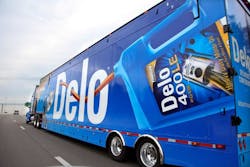I’ve talked about the impending introduction of the new CK-4 and FA-4 diesel truck engine oils with Leonard “Len” Badal, the global Delo brand manager for Chevron Lubricants, several times now and he’s always a great font of information – often on their particular characteristics, the end result of five years’ worth on what were previously called Proposed Category 11 or “PC-11” motor oils.
One thing Badal stressed to me about the CK-4 and FA-4 oils – each a different “sub-category” within the PC-11 specification – is that they were designed with new engine designs and component technology in mind.
Ostensibly they are formulated to maintain performance in a higher engine heat environment (new 2017 model engines may run almost 50 degrees hotter) yet also deliver better fuel economy, mainly via thinner viscosities, so an engine does not have to work as hard – and thus burns less fuel – moving such “lighter weight” oils around.
Yet he also pointed out to me that many of the “thinner” CK-4 and FA-4 blends heading to the market Dec. 1 – especially the 15W-40 and 10W-30 varieties – will be “backward compatible” to a significant degree; even back to 2010 model year engines, and with often longer oil drain intervals to boot.
That means fleets run a mix of late model and older trucks should be able to reap fuel economy gains and maintenance savings from longer drains, though perhaps not on the order of what fleets operating the latest and greatest greenhouse gas (GHG) compliant 2017 model engines with the thinnest oil blend will get.
Badal also recently pointed out that many truck OEMs are embracing the new FA-4 blend more broadly as a factory-fill option. Here’s what he knows at least so far regarding what engine oil the various OEMs plan to spec for 2017:
- Cummins Inc.: CK-4 – Cummins CES 20086 and FA-4 – Cummins CES 20087. Both CK-4 and FA-4 are approved for the new GHG-compliant 2017 Cummins IX-15 and IX-12 engines (Note: the IX-12 won’t be commercially available until 2018). CK-4 along with Cummins CES 20086 specification oils are also approved for use in older ISX and ISX-15 model engines, while FA-4 is not authorized for anything but IX-15 model engines at this time. With its new categories, Cummins will also its oil drain recommendations by 10,000 miles – from a maximum 40,000 to 50,000 miles – for new IX-15 engines using the new oils.
- Detroit Diesel: CK-4 – DFS 93K222 and FA-4 – DFS 93K223. Detroit Diesel has approved the backwards compatible CK-4 for older engines in Freightliner and Western Star trucks. FA-4 is approved for new GHG-complaint 2017 model engines along with EPA-complaint 2010 and 2013 engine models. The company has not announced an oil drain extension, but recommends using the new products in new engines. Detroit Diesel will start factory-filling new model engines with FA-4 and DFS 93K223 approved oil starting mid-December 2016.
- Volvo and Mack: CK-4 – Volvo VDS4.5, CK-4 – Mack EOS 4.5 and CK-4 – Renault VI RLD 4. No specification is being released for FA-4 for it will not be allowed for use in EITHER new or older Volvo or Mack diesel engines.
- Badal noted that Volvo and Mack specifications are built around tighter requirements for improved oil oxidation performance as measured by the new Volvo T-13 engine test versus the typical CK-4 or FA-4 Volvo T-13 requirements. That being said, Volvo is announcing a 10,000-mile oil drain extension (from 45,000 to 55,000 miles) for new engines using the new VDS4.5- or Mack EOS 4.5-approved CK-4 oils.
- Navistar: As of now, Navistar does not have its own OEM specification qualification program; it simply uses the API designations for engine oils. Most Navistar equipment is powered by Cummins engines, and so its oil recommendations will be the same as Cummins, including the oil drain extension. For its own N13 model diesel engine, CK-4 is recommended for all models, with FA-4 approved for new model GHG-compliant 2017 engines only. Yet Navistar will be factory-filling with CK-4 SAE 10W-30 diesel, Badal emphasized
- PACCAR: CK-4 for now with FA-4 to be announced in the future. Badal noted that PACCAR uses the API designations for its specifications with no specific OEM specification qualification program included. Kenworth and Peterbilt trucks are equipped with either a PACCAR MX or Cummins diesel engine and both engine models have been factory filled with Delo 400 XLE Synblend SAE 10W-30 (a CK-4-grade product) since back in mid-September. FA-4 oils may be used with the new Cummins IX-15 diesel engines once they started to be installed in Kenworth or Peterbilt trucks, but PACCAR has not committed yet to whether it will use FA-4 oils for its GHG-compliant 2017 model MX engines.
“Most OEMs are already starting to develop next generation engines and engine oils for launch between 2020 and 2025 – and almost all of the new oil development programs for these engines are focused on low HT/HS [High Temperature/High Shear] 5W viscosity grades [that will be] factory filled to meet stricter fuel efficiency and emission standards,” he explained in a recent blog post.
The hitch, however, is that such 5W oils cost more than comparable 10W and 15W grades – a LOT more, largely because they are full synthetics, he told me recently.
“The price difference between a 10W-30 and a 15W-40 isn’t much; they are within the ballpark of one another,” Badal pointed out. “But when you get to 5W blends, you are talking two to three times the cost of a 15W product.”
That doesn’t mean moving to 5W grades isn’t worth the extra money, he stressed; indeed, those blends can deliver greater improvements in fuel economy as well as longer oil drain intervals. The issue is this, though: a fleet must really justify those improvements by attaining them consistently, but that can be problematic based on a fleet’s duty cycle.
“It’s not a durability or performance issue; it’s a cost justification issue,” Badal emphasizes. “For example, we had one fleet double their oil drain interval while another only achieved a 15% extension. So it comes down to the type of engine and the duty cycle it’s working in. You have to drive a lot of value to make the transition to a 5W blend pay off.”
Something to keep in mind as we draw closer the dawn of a new diesel engine oil era.


